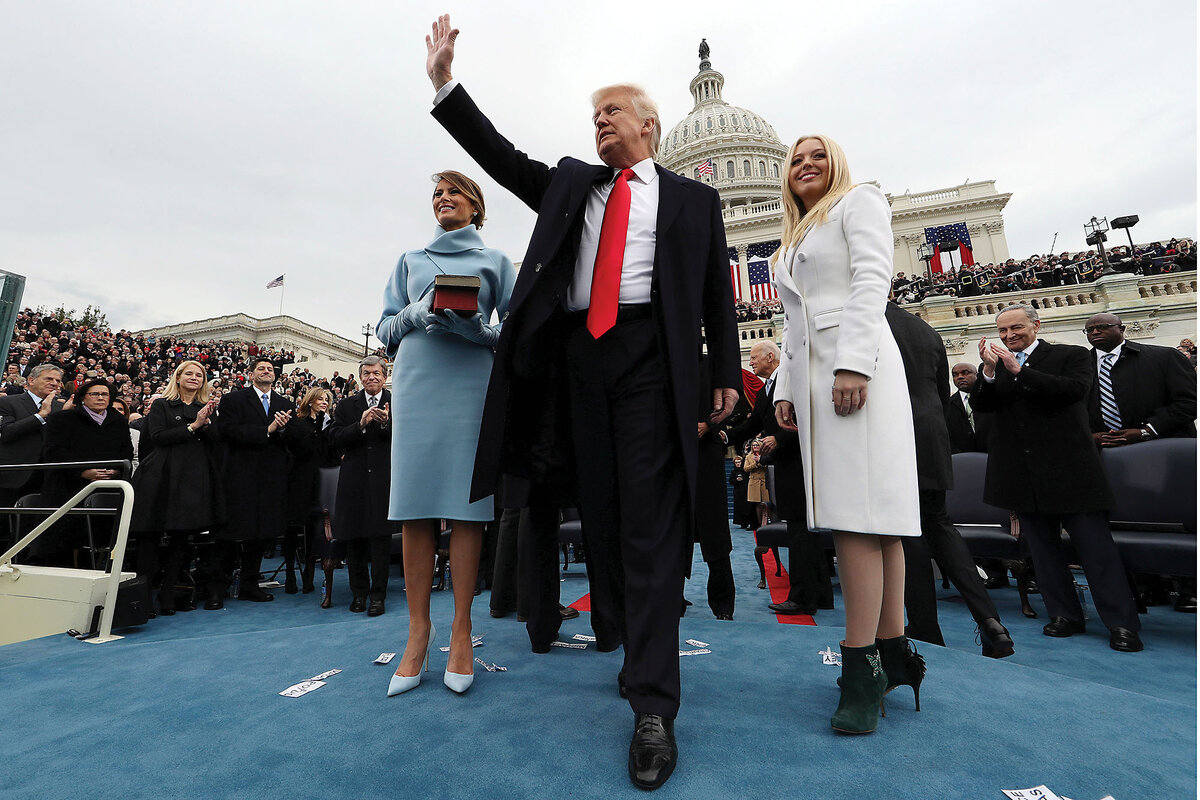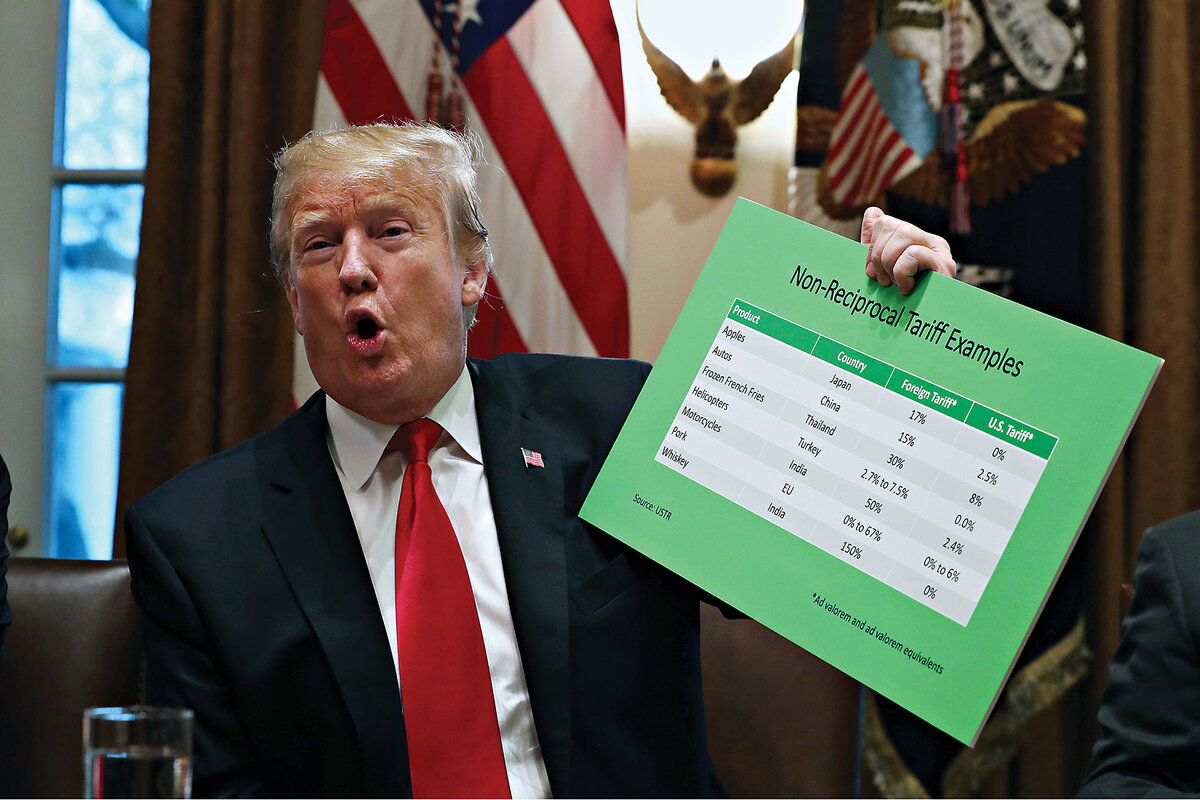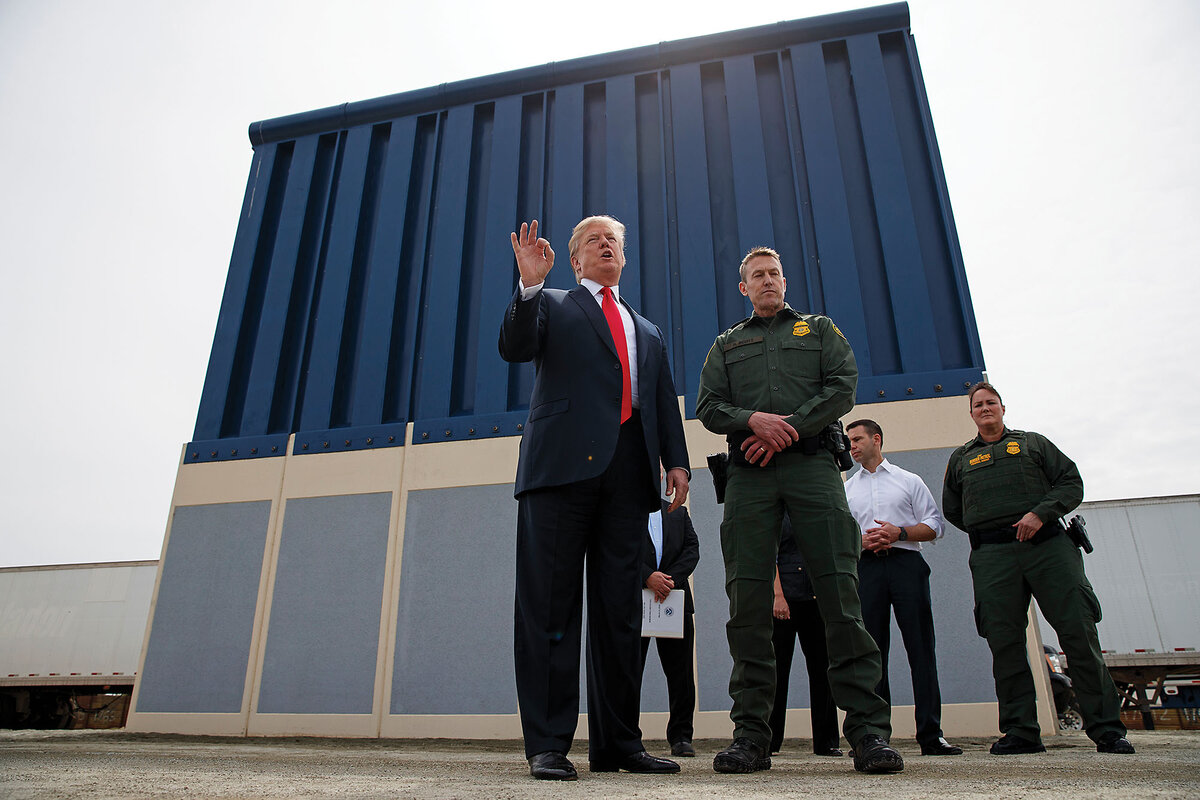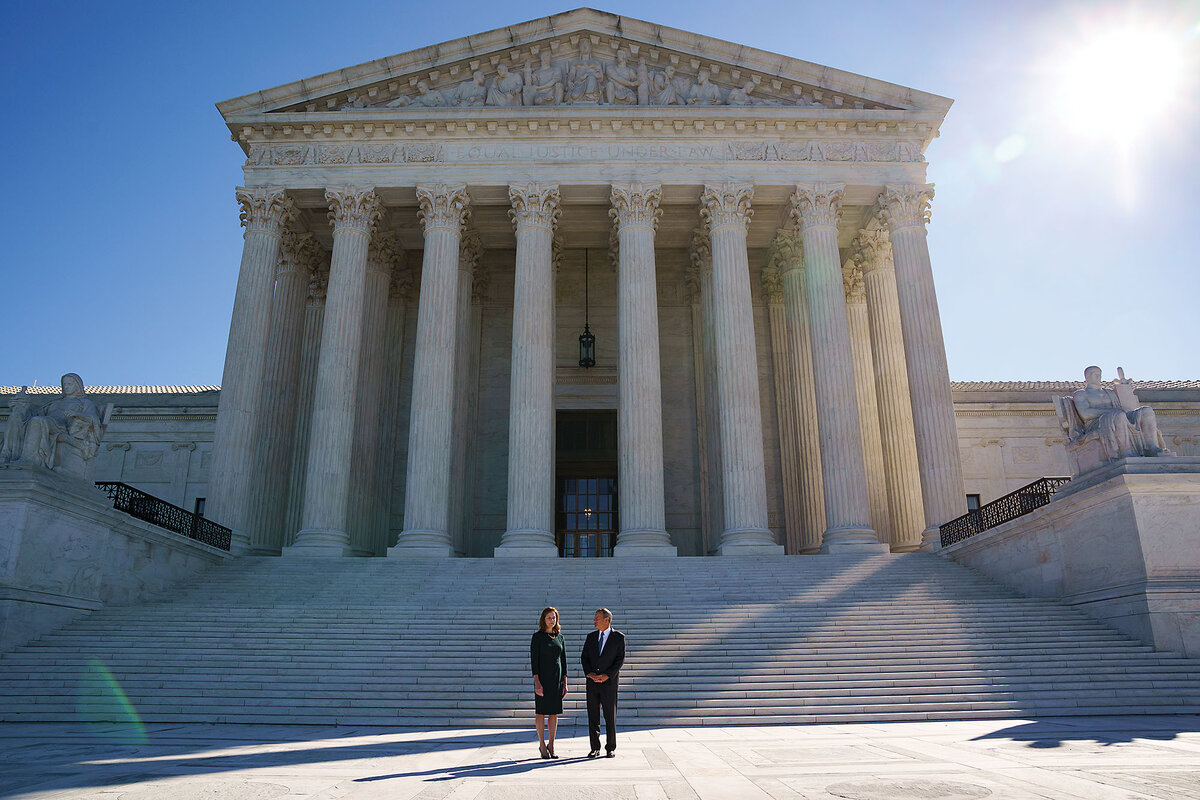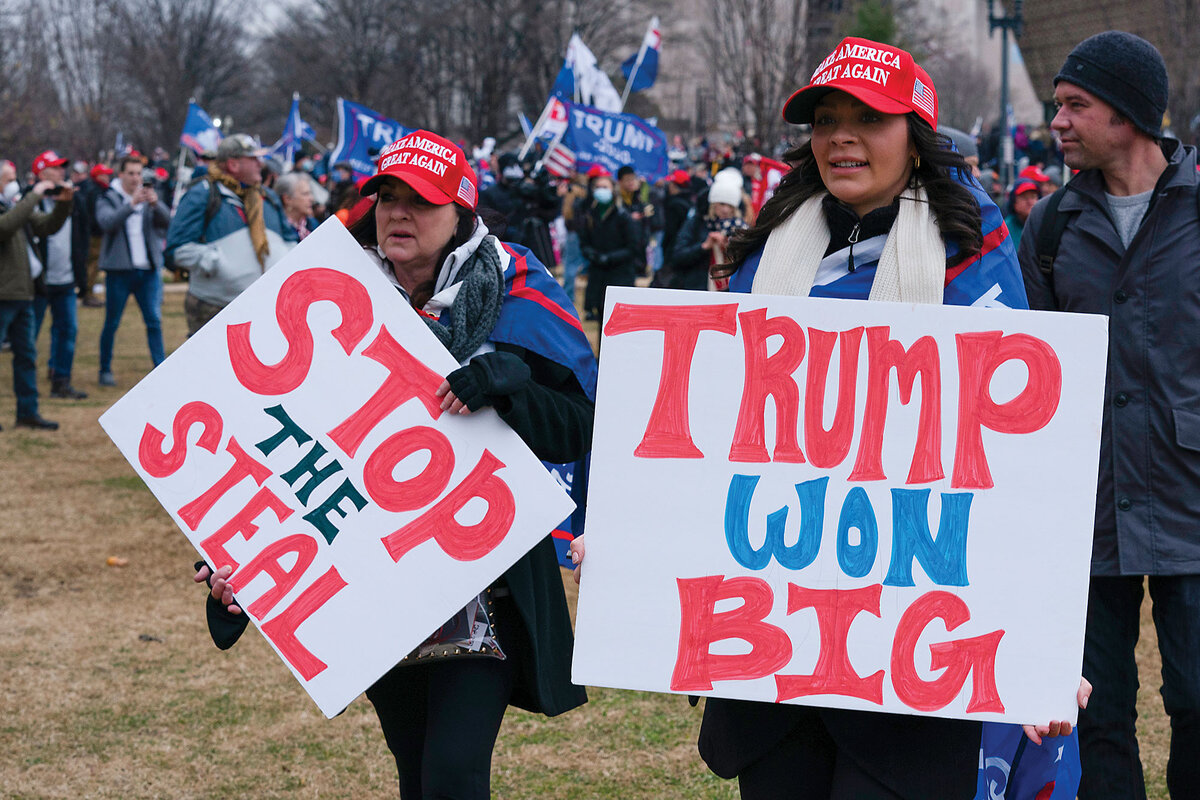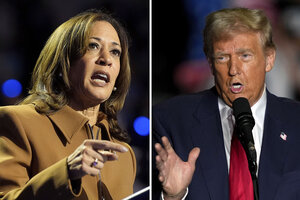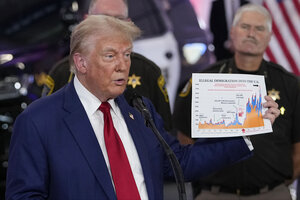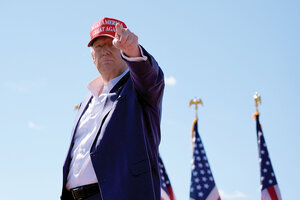What would a second Trump term look like? The first one provides clues.
Loading...
Donald Trump became the 45th U.S. president in January 2017, having never held public office or served in the military. To his supporters, his lack of a political track record was a selling point, since he promised to tear up the Washington playbook and offer a new approach on issues such as immigration and trade. But his inexperience in government, haphazard approach to policy, and inability to build a cohesive team led to results that didn’t always reflect the rhetoric. And his final year in office was dominated by the disruption of the COVID-19 pandemic. The result was a single presidential term marked by both achievements and multiple setbacks and scandals.
In pursuing his goals, Mr. Trump faced sustained and emotionally charged opposition from Democratic officials as well as resistance from military and civilian administrators, whom he labeled the “deep state.” He appointed three Supreme Court justices, paving the way for a landmark conservative victory on abortion. But he lost court battles over the legality of some of his more controversial policies. He was impeached twice, a record for any president. Yet even after the Jan. 6, 2021, attack by his supporters on the U.S. Capitol, which many Republican leaders blamed publicly on Mr. Trump, his party didn’t desert him, as it had President Richard Nixon in 1974.
In many ways, Mr. Trump’s greatest impact was on the Republican Party and the United States’ political culture. His presidential run in 2024 has come against a backdrop of multiple state and federal criminal indictments, all of which he ascribes to political persecution. As in past campaigns, he has served up a welter of bold, if vague, promises to voters. His record from his previous term in office offers a guide to what may follow, should he win reelection.
Economy: tax cuts and rising wages
During his 2016 campaign, Mr. Trump vowed to use his business experience to jump-start the U.S. economy. He inherited an expanding economy that was still recovering from the 2007-2009 financial crisis. His approach was to cut federal taxes; reduce regulations, particularly environmental rules; and reduce government spending.
In 2017, he signed the Tax Cuts and Jobs Act, which lowered taxes on corporations and individuals to the tune of $1.5 trillion over 10 years. Mr. Trump predicted that it would boost business investment and raise gross domestic product growth to 4% or higher. GDP did grow faster in 2018, hitting 3%, up from 2.5% in 2017, before slowing in 2019. Wages rose. Private investment also rose during the Trump presidency, as did after-tax corporate profits. Stock markets set new records.
Mr. Trump had promised to repeal and replace President Barack Obama’s Affordable Care Act – and said that this would reduce the deficit – but he failed to present a viable alternative to Congress. His tax cuts, along with spending bills he signed, increased the prepandemic budget deficit from $680 billion to $1 trillion in 2019.
By the end of his term, emergency federal spending on the pandemic had hiked the national debt to a post-World War II high.
Busting the consensus on trade
Many of Mr. Trump’s economic policies hewed to post-Ronald Reagan GOP orthodoxy. But not on trade. He rejected the consensus in Washington, among Democrats and Republicans, that free trade benefits U.S. companies and consumers.
Long before he ran for president, Mr. Trump seethed at what he saw as unfair trade practices by other countries. Once in office, he imposed tariffs on Chinese goods and on imported steel and aluminum, while seeking to renegotiate trading agreements with Mexico, Canada, and countries in Europe. His tariffs applied to products collectively worth around $380 billion, according to the Tax Foundation. While Mr. Trump claimed that foreign exporters bore the costs, multiple studies have shown that U.S. consumers paid higher prices for tariff-affected goods.
Steel producers and other domestic industries welcomed the tariffs and announced increases in investment and hiring. Those gains were offset, however, by losses in industries that use imported parts to produce finished goods and by exporters who faced retaliatory tariffs. For example, China imposed 25% tariffs on U.S. agricultural products, resulting in a federal bailout for farmers.
Still, Mr. Trump’s attacks on free trade proved politically popular, including in regions impacted by shuttered plants and job losses. By targeting China in particular, he raised doubts about the benefits of integration between the world’s two largest economies.
“He effectively woke the U.S. up to the reality that Chinese trade policy was in fact extremely disruptive when it came to the U.S. and the global trading system,” says Robert Lawrence, a professor of international trade at the Harvard Kennedy School.
Yet Mr. Trump’s ultimate goal of reducing the U.S. trade deficit – the value of the goods it imports minus the value of exports – didn’t pan out. The overall deficit rose in three out of the four years of his term. While the share of Chinese goods fell, importers switched to suppliers in Mexico and Vietnam.
Trump administration officials renegotiated the North American Free Trade Agreement, now known as the United States-Mexico-Canada Agreement, and cut deals with other exporting countries, using tariffs as leverage. But China balked at U.S. demands to open up its economy to greater competition. Today, China continues to apply high tariffs to U.S. goods, while lowering tariffs for other exporting countries. “Americans and their products are more discriminated against than they had been before,” says Professor Lawrence.
On immigration, tougher tone and action
In all three of his campaigns, Mr. Trump has made immigration a signature issue. In 2016, he vowed to stop illegal immigration, deport millions of unauthorized migrants, and build a wall along the U.S.-Mexico border that Mexico would pay for. He also called for a “total and complete shutdown of Muslims entering the United States,” citing the security risk posed by extremists.
The “Trump effect” on immigration policy was far-reaching: Nearly 500 administrative changes were made, mostly via executive actions. Refugee resettlement was slashed to the lowest level since 1980. Asylum-seekers faced far greater scrutiny, and those crossing from Mexico were deemed ineligible if they hadn’t claimed asylum in third countries during their journeys.
The most controversial policy was family separations: Authorities deported adult migrants back to their home countries and took custody of their children. As many as 5,000 children were separated from their parents under Mr. Trump, who promoted the policy as a deterrent to families crossing illegally. A court ruled in 2018 that the policy was illegal and ordered families to be reunited.
Mr. Trump’s executive order rejecting entry to refugees and travelers from seven majority-Muslim countries, known as the “Muslim ban,” was also blocked by federal courts in 2017. A revised order that included Venezuelan officials and North Koreans was ruled constitutional by the Supreme Court in 2018.
Other categories of migrants were largely unaffected, though the Trump administration instituted multiple rule changes that caused delays in visa processing, says Doris Meissner, former head of the U.S. Immigration and Naturalization Service. “He was certainly successful in slowing the immigration system down with technical changes.”
Border apprehensions – a major talking point in the 2024 campaign – fell in Mr. Trump’s first year, in response to his tough rhetoric about deportations. But as the threat appeared to subside, apprehensions more than doubled in 2019. The administration responded by forcing asylum-seekers to wait in Mexico until their initial hearings.
Following a battle with Congress, the bill for Mr. Trump’s border wall was paid by U.S. taxpayers. A total of 458 miles of barricades, mostly replacement fencing, was constructed during his administration, according to a Customs and Border Protection report. By the end of his term, roughly 36% of the 1,954-mile border had some kind of fence or wall.
The Supreme Court and judiciary under Trump
Mr. Trump was the first president since Richard Nixon to appoint three Supreme Court justices. The first, Neil Gorsuch, replaced Justice Antonin Scalia, a conservative who died during President Obama’s final year in office, after which Senate Republicans refused to consider a replacement, leaving the position open.
Mr. Trump’s second pick, Brett Kavanaugh, weathered a stormy Senate hearing to replace a retiring Republican-appointed justice who’d often served as a swing vote. His third appointee, Amy Coney Barrett, the youngest member of the court, replaced late liberal Justice Ruth Bader Ginsburg in 2020, locking in a conservative supermajority.
In addition to making those appointments, Mr. Trump nominated over 220 federal judges, including appellate circuit judges.
When he ran for president in 2016, Mr. Trump promised to appoint judges who would rule favorably on conservative priorities such as gun rights, abortion restrictions, and religious liberty. The Supreme Court, under his appointed justices, has largely delivered on those promises. Among its most consequential rulings were the Dobbs v. Jackson Women’s Health Organization decision in 2022, which ended a national right to abortion, and a 2023 decision against affirmative action in college admissions.
Of potentially great personal impact for Mr. Trump was the court’s ruling in July that granted presidents broad immunity from criminal prosecution, after an appeal by Mr. Trump’s team in a federal election interference case. The ruling, which surprised many legal scholars in its scope, all but guaranteed that Mr. Trump wouldn’t go on trial before this November’s election.
Handling the pandemic
In January 2020, a new coronavirus first detected in China began showing up in the U.S. Mr. Trump’s advisers warned him that a coronavirus pandemic, for which no vaccine or medical cure existed, could lead to millions of deaths.
In public, Mr. Trump initially downplayed the outbreak and claimed the virus would “miraculously” go away. Even after a pandemic was declared in March and states restricted public gatherings and closed businesses, he insisted the risk was low. In White House briefings, he promoted unproven cures and contradicted his own scientific advisers.
By May, the U.S. had the world’s highest COVID-19 toll, with 100,000 deaths. That month, Mr. Trump approved Operation Warp Speed, a $10 billion investment in vaccine development and manufacturing. Seven months later, an emergency-use vaccine became available – just weeks after Mr. Trump lost reelection, in part because of disapproval of how he handled the pandemic.
Mr. Trump’s defenders argue that he faced a once-in-a-century pandemic and that other wealthy nations also failed to prevent transmission and deaths. They also highlight his decisive action on vaccines. Uptake of COVID-19 and other vaccines in the U.S., however, has become increasingly skewed by partisan beliefs, due to Republican skepticism.
By the time Mr. Trump left office, more than 400,000 deaths had been attributed to COVID-19. One international panel convened by The Lancet, a medical publication, estimated that 40% of these deaths could have been averted, based on outcomes in peer countries with different policies. It criticized Mr. Trump for failing to develop a national strategy for personal protective equipment and testing, while denigrating mask-wearing and other mitigation measures.
David Himmelstein, a co-chair of the panel, says the U.S. had public health disadvantages, including unequal access to health care and high levels of chronic diseases, that predated Mr. Trump and hobbled the pandemic response. Still, “The U.S. really stands out for its bad results,” says Dr. Himmelstein, a professor of public health at Hunter College in New York. “I think it’s pretty clear that alternative leadership could’ve prevented many deaths. How many we’ll never know.”
Effects on U.S. democracy
In 2016, Mr. Trump won an Electoral College majority despite receiving fewer votes overall. He claimed that millions had “voted illegally” for his opponent, Hillary Clinton, and formed a commission to investigate. It disbanded in 2018 without presenting any evidence to support the claim.
Four years later, he returned to the same playbook. In August 2020, he told supporters, “The only way we’re going to lose this election is if the election is rigged.”
Early results on election night raised Republican hopes of victory. But as more ballots were tallied and states called, the tide began to turn in favor of Joe Biden. Later that night, Mr. Trump declared a “fraud on the American public” and claimed, falsely, that he had won the election. “We want all voting to stop,” he said in a live broadcast.
His claims became the basis of “Stop the Steal,” an effort by his campaign and activists to toss out ballots cast for Mr. Biden. Multiple recounts in six battleground states found no evidence of significant irregularities. Mr. Trump’s attorneys filed 64 lawsuits containing 187 counts in six states, of which 34 were dismissed. Of the remaining 30 cases that included a hearing on the merits, only one was successful, in Pennsylvania, but it affected too few votes to change the result.
Mr. Trump personally called election officials in Georgia and Arizona to urge them to decertify election results. All rejected his requests. He continued to claim that he had won “in a landslide,” even after Attorney General William Barr told him that investigators had found no evidence for his claims, which included conspiracy theories about voting machines.
On Dec. 12, 2020, the U.S. Supreme Court declined to hear a lawsuit filed by Texas against four battleground states that sought to overturn their results. Two days later, the Electoral College met to affirm Mr. Biden’s victory.
Mr. Trump tried repeatedly to persuade Vice President Mike Pence to block the ceremonial counting of Electoral College votes in Congress on Jan. 6, 2021. After Mr. Pence refused, Mr. Trump held a massive rally near the White House that day and urged attendees to march to the Capitol and “fight like hell” to stop the certification. He then retreated to the White House to watch TV coverage.
Thousands of Trump supporters attacked the Capitol, forcing Mr. Pence and other lawmakers to shelter. More than 140 police officers were injured in the melee, and several later died. Four protesters also died that day. Later that night, after order was restored, Congress confirmed Mr. Biden as president-elect; 121 Republican House members and six senators voted against certification.
Prosecutors used these actions and others by the former president and his allies to convince a grand jury in Washington to indict Mr. Trump in January 2023, on four counts of election interference. He has also been indicted in Georgia over his calls to state election officials in 2020. Neither case has gone to trial.
Mr. Trump was separately convicted by a New York jury for falsifying business records over a hush money payment in 2016 to a porn star. He has appealed the verdict. He also faces a federal criminal case over the removal of classified documents from the White House.
His presidential term ended Jan. 20, 2021, the day of Mr. Biden’s inauguration. Earlier that day, Mr. Trump left the White House by helicopter, en route to Florida. He was the first living president not to attend the inauguration of his successor since 1869.
Also see our parallel story on Kamala Harris’ record, from San Francisco district attorney to vice president.






